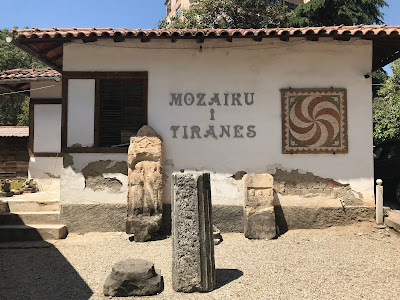Rescue excavations adjacent to the site of the Tirana mosaic in Albania’s capital have brought to light a continuation of the villa complex and also two burials. The archaeological intervention came about following the discovery of ancient remains during building work earlier this year. Local residents alerted the authorities to the damage being done to archaeological material by the construction work, and a rescue excavation commenced.
Trenches in areas on two sides of the mosaic site have exposed the continuation of the walls of the villa complex, literally extending our knowledge of the site. The Tirana Mosaic was originally discovered during the building of an apartment block in 1972. Excavations at that time brought to light several phases of a dwelling, the earliest part of which dated back to the 1st century CE. This dwelling was then rebuilt in the 3rd century to form a complex consisting of living quarters and an area for processing of agricultural products: a small ‘villa rustica’. In the 4th or 5th century CE an apse was added to part of the building, converting an area of it for use by the early Christian community of the area. With the addition of the apse, one of the large rooms of the villa became the nave of a Christian Basilica, and an adjacent room the narthex. Some architectural fragments that were used in the construction of the church have been dated to the reign of Constantine I (306-337).
Several rooms in the complex feature mosaics, made up of a variety of geometric motifs. The mosaics are made of tessera of local stone, apart from the red sections, which are made of terracotta. The mosaics are not complete and have been through several restorations but enough remain (under a modern protective roof) to see a wide range of designs including several complex interlocking patterns and a motif that resembles a spinning wheel. Unfortunately some birds and fish (common symbols of Christianity) that had been inserted into the mosaic in the narthex when the building was converted into a basilica are now lost.
 |
| The new excavations showing the drainage channel |
Two burials were also discovered, one in which the individual was laid out on a ceramic 'tiles'. It is clear that the walls continue beyond the current trenches: archaeologist Mariglen Meshini has acknowledged that the discoveries of additional rooms are adding to the understanding of the existing monument, for example the discovery of coins will help with a more precise dating.
 |
| l. Tiles now. r. Ministry of Culture photo of burial |
The excavation report is now being written and will be will be reviewed by the National Council of Material Cultural Heritage who will be decide whether to continue archaeological excavations, and perhaps investigate other areas adjacent to the current site.
 |
| Paleochristian architectural fragment |
 |
| Roman grave stele |



Oh my goodness! a tremendous article dude. Thank you However I'm experiencing concern with ur rss . Don’t know why Unable to subscribe to it. Is there anyone getting identical rss drawback? Anyone who knows kindly respond.
ReplyDeleteCar service from Rome to Positano
Thanks for sharing this blog . such a nice blog .Keep sharing such blog posts. and visit this site for affordable tour package>>>>>>cambodia and Vietnam tours packages
ReplyDelete.
Thank you for sharing this blog.
ReplyDeleteMust appreciate your efforts to posting information about student essentials.
student accommodation montreal
Mosaic was a true innovation of ancient times. Visit mine here
ReplyDeleteRespect and I have a neat proposal: What To Expect When Renovating A House house remodel contractors
ReplyDelete